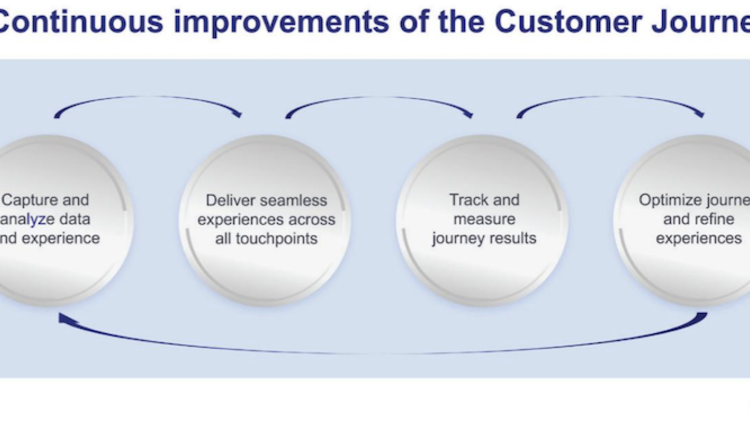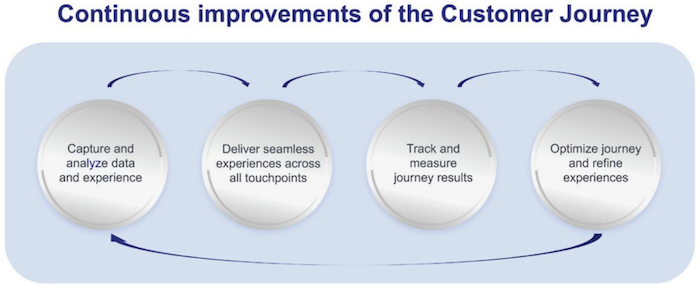
Customer experience is the heart of an organization’s relationship with its customers. Post-pandemic customer expectations are still higher than ever. Consumers want to be able to interact with organizations on their own terms, using and switching between channels as they prefer. They expect their experience with any organization to mimic those of customer experience leaders like Amazon or Google. Anything less can lead to dissatisfaction and a risk of churn.
To successfully manage this, most organizations must invest in solutions enabling experienced teams to deliver a seamless and consistent customer experience across all touchpoints in every business unit, ultimately putting the customer at the center of their efforts. Software that focuses on journey mapping, journey management or campaigns are enticing solutions to consider for gaining visibility into customer interactions or driving digital transformation, but address and solve these objectives in very different ways. To avoid getting caught up in the buzzword of the customer journey, it helps to understand what these solutions should help you accomplish.
THE CUSTOMER JOURNEY
The customer journey is the end-to-end interaction path a customer takes to complete a transaction with an organization. Customer journeys include everything that happens before, during and after the interaction of acquiring products or accessing services. Customer journeys stretch across multiple channels and touchpoints, often lasting days or weeks. The customer journey is truly omnichannel, as customers may interact with communications, call center agents, in-person locations or other touchpoints like social media.
CUSTOMER JOURNEY MAPPING
Since all business models lose strength over time, organizations should continuously review their everyday customer-facing processes to ensure they still improve and add value to their customer relationships. The ability to offer a suitable customer experience depends on up-to-date knowledge of customers’ desires, motivations and interests and how this information can be used to drive specific behaviors and desired business outcomes like increasing digital adoption.
As a visual representation of customer interactions with an organization, a customer journey map is a helpful tool for undertaking and sharing this review of processes: Every customer interaction can be analyzed — from the customer perspective. Thus, the Customer Journey Map provides valuable insights into customers’ needs, preferences and behaviors, which are then used to optimize customer experiences to foster loyalty and drive growth.
A typical Customer Journey Map includes the following elements:
- Customer journey stages are the distinct phases customers go through when interacting with an organization, such as awareness, consideration, decision, retention and advocacy.
- Touchpoints are how customers interact with an organization at each stage, such as website, mobile app, call center and social media. Identifying all touchpoints helps organizations understand how customers interact and where the opportunities for improving customer experience are.
- Customer goals and objectives are different at each stage. Understanding these will help organizations to develop successful strategies for each stage.
- Emotions and feelings customers experience at each stage of the journey. Organizations must ensure a positive and engaging customer experience at each stage.
BENEFITS, PITFALLS AND THE FUTURE STATE
By mapping out the customer journey, organizations will better understand their customers’ needs and expectations and how they interact with their organization. This understanding can then be used to improve the customer experience and drive business growth.
However, several pitfalls exist. Often, organizations use outdated data or assumptions to map the journey. Working with credible data, such as present research and customer interviews, is critical to bringing the external perspective into the customer journey map.
In a new prioritization of improvements, the future state of the ideal customer journey can be mapped from the customers’ perspective. Mapping it separately, is the chance to dream up new experiences for customers that leverage (new) technology, create better outcomes and improve the customer experience across the whole journey.
SUCCESS? – NOT YET!
The benefits of improved customer experience will include increased customer satisfaction, higher customer loyalty, more sales and enhanced brand reputation – all leading to increased sales or performance of the organization. Additional benefits would be:
- Reduced costs due to churn being less likely – thus, saved customer acquisition cost. Improved employee morale due to employees being motivated by posi-tive customer contacts – which could lead to increased productivity and efficiency.
- Modernization is not a destination. As customer expectations constantly evolve, customer experience and digital transformation success are not guaranteed and might decrease over time. Thus, it is imperative to set up a process that involves a continuous cycle of collecting and analyzing the data, delivering experiences, measuring results, and optimizing in areas that need improvement — the core of customer journey management.

CUSTOMER JOURNEY MANAGEMENT
Journey mapping is one part of a greater journey management solution. It enables organizations to do more than model the ideal journey by allowing them the ability to learn from and act on customer behaviors. The main reason for implementing customer journey management is to increase an organization’s capacity to provide value to its customers, as satisfied customers return value to an organization.
Next to identifying and designing the customer journey interactions, Nielsen Norman Group identifies the understanding of customer needs through research and journey analytics and orchestrating interventions and personalization based on behavioral data as core competencies of Journey Management.
In summary, successful journey management of an organization should include the following activities:
- Journey mapping and design to visualize and communicate customer interactions for reaching a specific goal across all touchpoints.
- Journey insights to understand the customer from behavioral data tracked across touchpoints and the impact on desired journey goals.
- Journey orchestration to react to customers’ behavior to improve customer experience and foster progress towards the desired goals, respecting all insights.
- Journey optimization to track journey success and use predictions and recommendations from AI to improve customer experience and reach goals.
By improving the customer experience and enabling better services, digital transformation drives customer satisfaction. Customer journey mapping is the basis for understanding how customers interact with an organization and detecting pain points within the journey. However, by investing in journey management solutions, Organizations can expand their scope of customer experience management by automating the measurement of data at every customer touchpoint, orchestrating the appropriate next event, and using insights over time to optimize and improve quickly.
While application modernization is a big undertaking, it rewards an organization with improved performance, security, scalability and the ease of adding functionality for customer success, such as responding faster and more targeted to customer requests and interactions. Organizations that invest in journey management are equipped to understand what customers expect, empowering them to provide personalized experiences and react immediately through journey orchestration to customer behavior. Thus, further improving customer satisfaction and loyalty with smarter Journeys that deliver on strategic business objectives such as accelerating digital adoption.
STEPHANIE PIERUCCINI is a Senior Manager of Product for OpenText CCM. In this role she is responsible for CCM Orchestration for OpenText Exstream as well as the StreamServe and Exstream platform solutions. Her experience comes from a strong knowledge of communication and production management from creation through delivery acquired from covering the print, marketing and CCM markets as an analyst and consultant with InfoTrends as well as serving as the channel development manager for CCM and digital transformation solutions at Neopost USA (Now Quadient).
FRANK STEFFEN serves Core Experience Insights as product manager, a product within OpenText Experience Cloud that allows marketers to plan, launch, and measure experiences across different touchpoints along the customer journey. Frank is passionate about helping clients to achieve their goals and improve their performance by leveraging AI and analytics in their customer experience projects.







